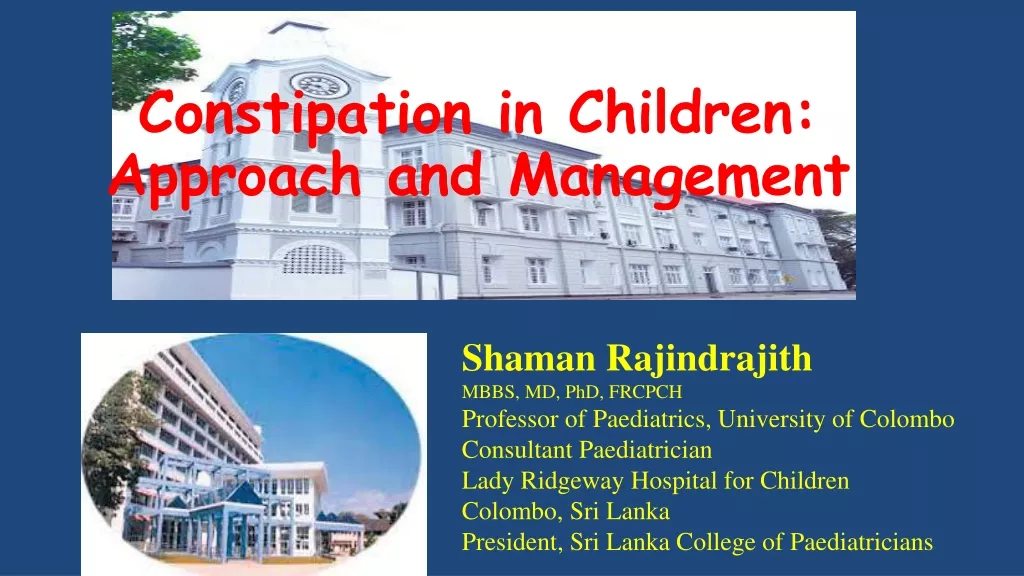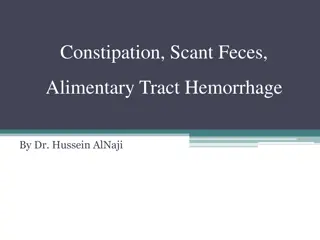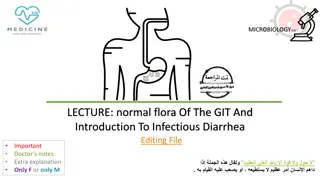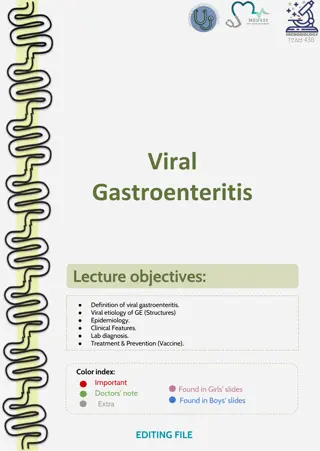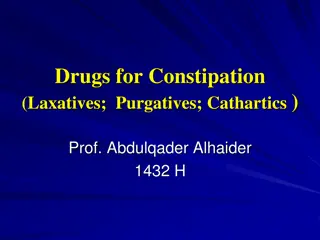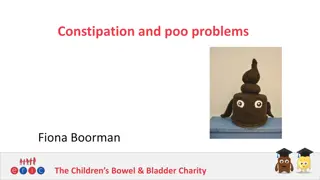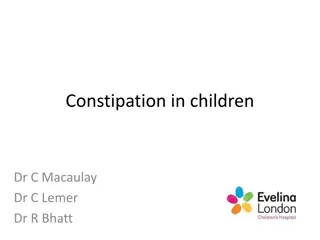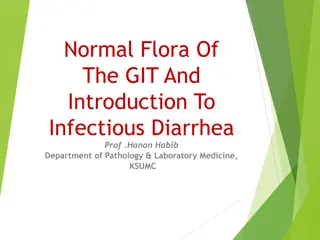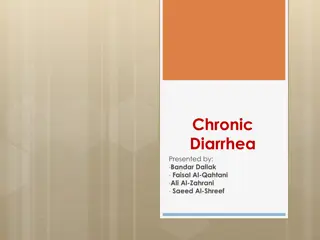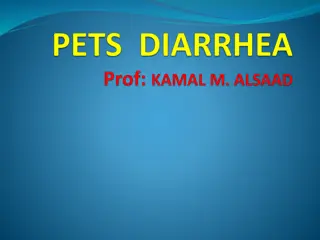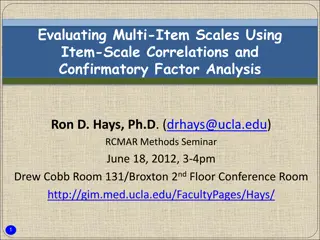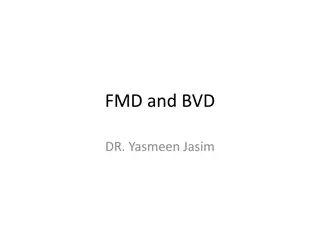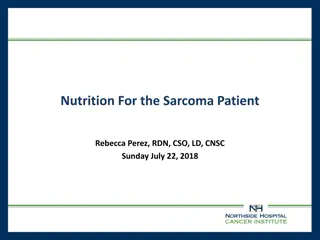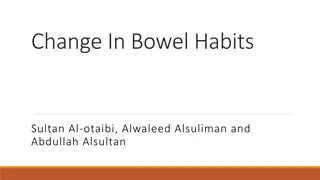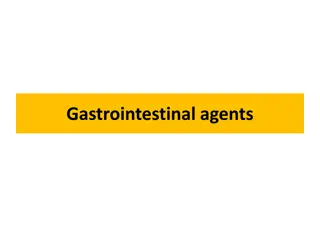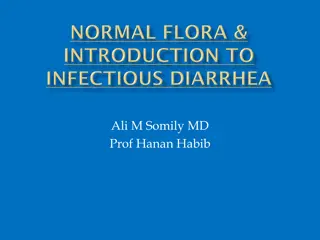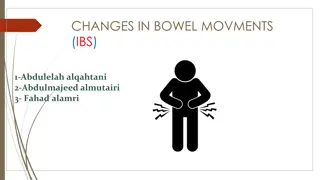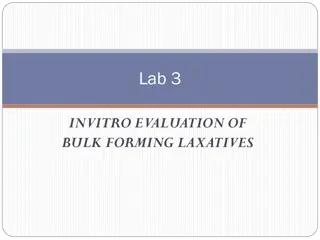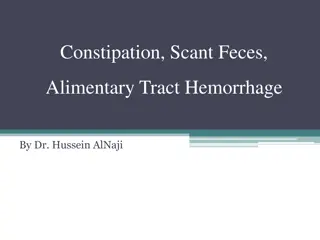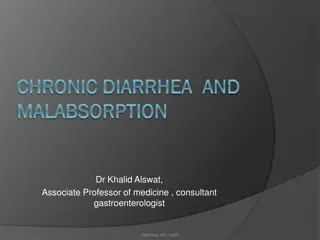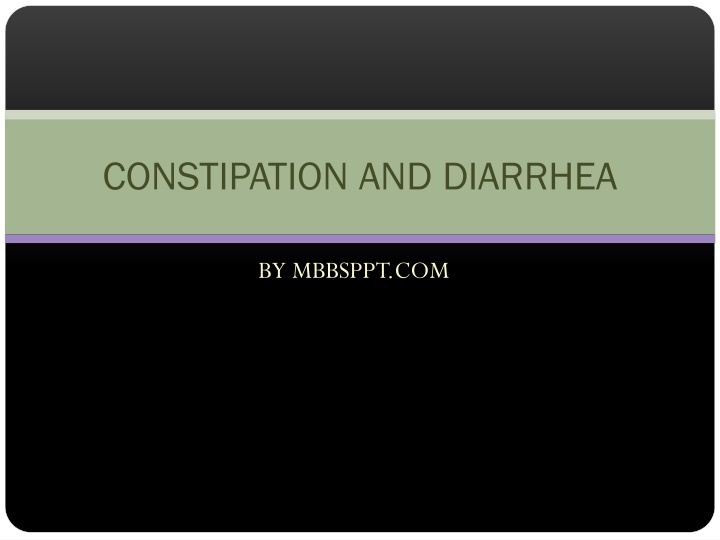
The Causes and Treatment of Constipation
Learn about the symptoms, causes, and treatment options for constipation. Discover how diet, medication, and lifestyle factors can affect bowel movements and overall digestive health. Find out how to differentiate between constipation and other gastrointestinal conditions.
Download Presentation

Please find below an Image/Link to download the presentation.
The content on the website is provided AS IS for your information and personal use only. It may not be sold, licensed, or shared on other websites without obtaining consent from the author. If you encounter any issues during the download, it is possible that the publisher has removed the file from their server.
You are allowed to download the files provided on this website for personal or commercial use, subject to the condition that they are used lawfully. All files are the property of their respective owners.
The content on the website is provided AS IS for your information and personal use only. It may not be sold, licensed, or shared on other websites without obtaining consent from the author.
E N D
Presentation Transcript
CONSTIPATION AND DIARRHEA BY MBBSPPT.COM
Constipation refers to bowel movements that are infrequent and/or hard to pass. Constipation is a common cause of painful defecation. Severe constipation includes obstipation (failure to pass stools or gas) and fecal impaction .
Constipation is a symptom with many causes. These causes are of two types: obstructed defecation and colonic slow transit (or hypomobility). About 50% of patients evaluated for constipation at tertiary referral hospitals have obstructed defecation Causes of colonic slow transit constipation include diet, hormones, side effects of medications, and heavy metal toxicity
DEFINITION The definition of constipation includes the following: infrequent bowel movements (typically three times or fewer per week) difficulty during defecation (straining during more than 25% of bowel movements or a subjective sensation of hard stools), or the sensation of incomplete bowel evacuation.
CAUSES OF CONSTIPATION The causes of constipation can be divided into congenital, primary, and secondary. The most common cause is primary and not life threatening. In the elderly, causes include: insufficient dietary fiber intake, inadequate fluid intake, decreased physical activity, side effects of medications, hypothyroidism, and obstruction by colorectal cancer
Primary Primary or functional constipation is ongoing symptoms for greater than six months not due to any underlying cause such as medication side effects or an underlying medical condition. It is not associated with abdominal pain thus distinguishing it from irritable bowel syndrome. It is the most common cause of constipation
Diet Constipation can be caused or exacerbated by a low fiber diet, low liquid intake, or dieting Medication Many medications have constipation as a side effect. These include- opioid analgesics, codeine , diuretics, antidepressants, antihistamines, antispasmodics, anticonvulsants, and aluminum antacids
Metabolic & muscular Metabolic and endocrine problems which may lead to constipation include: hypercalcemia, hypothyroidism, diabetes mellitus, cystic fibrosis, and celiac disease. Constipation is also common in individuals with muscular and myotonic dystrophy.
Structural abnormalities Constipation has a number of structural (mechanical, morphological, anatomical) causes, including: colon cancer, anal fissures, proctitis, and pelvic floor dysfunction
Functional Constipation also has functional OR neurological causes, including: Spinal cord lesions and injury Parkinson s disease Anismus (pelvic floor dyssynergy), Descending perineum syndrome, and Hirschsprung's disease. -In infants, Hirschsprung's disease is the most common medical disorder associated with constipation. Psychological Voluntary withholding of the stool is a common cause of constipation. The choice to withhold can be due to factors such as fear of pain, fear of public restrooms, or laziness
Diagnostic Approach Diagnostic Approach The diagnosis is essentially made from the patient's description of the symptoms. Bowel movements that are difficult to pass, very firm, or made up of small hard pellets qualify as constipation. Other symptoms related to constipation can include bloating, distension, abdominal pain, headaches, a feeling of fatigue and nervous exhaustion, or a sense of incomplete emptying. Inquiring about dietary habits will often reveal a low intake of dietary fiber, inadequate amounts of fluids, poor mobility or immobility , lack of exercise or medications that are associated with constipation
During physical examination manually palpable lumps of stool may be detected on palpation of the abdomen. Rectal examination gives an impression of the anal sphincter tone and whether the lower rectum contains any feces or not. Rectal examination also gives information on the consistency of the stool, presence of hemorrhoids, admixture of blood and whether any tumors, polyps or abnormalities are present. Physical examination may be done manually , or by using a colonoscope. X-rays of the abdomen, generally only performed if bowel obstruction is suspected, may reveal extensive impacted fecal matter in the colon, and confirm or rule out other causes of similar symptoms
Chronic constipation (symptoms present at least three days per month for more than three months) associated with abdominal discomfort is often diagnosed as irritable bowel syndrome (IBS) when no obvious cause is found
Colonic propagating pressure wave sequences (PSs) are responsible for discrete movements of the bowel contents and are vital for normal defecation. Deficiencies in PS frequency, amplitude and extent of propagation are all implicated in severe defecatory dysfunction. Mechanisms that can normalize these aberrant motor patterns may help rectify the problem
Prevention Prevention Constipation is usually easier to prevent than to treat. Following the relief of constipation, maintenance with adequate exercise, fluid intake, and high fiber diet is recommended.
Treatment Treatment The main treatment of constipation involves the increased intake of water, and fiber (either dietary or as supplements). The routine use of laxatives is discouraged, as having bowel movements may come to be dependent upon their use. Enemas can be used to provide a form of mechanical stimulation. However, enemas are generally useful only for stool in the rectum, not in the intestinal tract In cases of chronic constipation, prokinetics may be used to improve gastrointestinal motility.
Complications and Prognosis Complications and Prognosis Complications that can arise from constipation include hemorrhoids, anal fissures, rectal prolapse, and fecal impaction. Straining to pass stool may lead to hemorrhoids. In later stages of constipation, the abdomen may become distended, hard and diffusely tender. In Severe cases of faecal impaction, patient may exhibit symptoms of bowel obstruction (vomiting, very tender abdomen)
DIARROEA Diarrhea also spelled diarrhoea, is the condition of having three or more loose or liquid bowel movements per day. It is a common cause of death in developing countries and the second most common cause of infant deaths worldwide. The loss of fluids through diarrhea can cause dehydration and electrolyte imbalances
Types of diarroea Secretory Secretory diarrhea means that there is an increase in the active secretion, or there is an inhibition of absorption. There is little to no structural damage. The most common cause of this type of diarrhea is a cholera toxin that stimulates the secretion of anions, especially chloride ions. Therefore, to maintain a charge balance in the lumen, sodium is carried with it, along with water. . It continues even when there is no oral food intake.
Osmotic Osmotic diarrhea occurs when too much water is drawn into the bowels. This can be the result of malabsorption(e.g., pancreatic disease or celiac disease), in which the nutrients are left in the lumen to pull in water. Osmotic diarrhea can also be caused by osmotic laxatives (which work to alleviate constipation by drawing water into the bowels). In healthy individuals, too much magnesium or vitamin C or undigested lactose can produce osmotic diarrhea and distention of the bowel.
A person who has lactose intolerance can have difficulty absorbing lactose after an extraordinarily high intake of dairy products. In persons who have fructose malabsorption, excess fructose intake can also cause diarrhea. Sugar alcohols such as sorbitol (often found in sugar-free foods) are difficult for the body to absorb and, in large amounts, may lead to osmotic diarrhea. Osmotic diarrhea stops when offending agent (e.g. milk, sorbitol) is stopped.
Exudative Exudative diarrhea occurs with the presence of blood and pus in the stool. This occurs with inflammatory bowel diseases, such as Crohn's disease or ulcerative colitis, and other severe infections such as E. coli or other forms of food poisoning
Motility-related Motility-related diarrhea is caused by the rapid movement of food through the intestines (hypermotility). If the food moves too quickly through the gastrointestinal tract, there is not enough time for sufficient nutrients and water to be absorbed. This can be due to a vagotomy or diabetic neuropathy. Hyperthyroidism can produce hypermotility and lead to diarrhea. Diarrhea can be treated with antimotility agents (e.g. loperamide). Hypermotility can be observed in people who have had portions of their bowel removed, allowing less total time for absorption of nutrients
Inflammatory Inflammatory diarrhea occurs when there is damage to the mucosal lining or brush border, which leads to a passive loss of protein-rich fluids, and a decreased ability to absorb these lost fluids. Features of all three of the other types of diarrhea can be found in this type of diarrhea. It can be caused by bacterial infections, viral infections, parasitic infections, or autoimmune problems such as inflammatory bowel diseases. It can also be caused by tuberculosis, colon cancer, and enteritis
Dysentery Generally, if there is blood visible in the stools, it is not diarrhea, but dysentery. The blood is trace of an invasion of bowel tissue. Dysentery is caused by Shigella, Entamoeba histolytica, and Salmonella infections
Differential diagnosis Differential diagnosis Acute Diarrhea is most commonly due to viral gastroenteritis with rotavirus, which accounts for 40% of cases in children under five. In travelers however bacterial infections predominate. Various toxins such as mushroom poisoning and drugs can also cause acute diarrhea
Chronic diarrhea can be the part of the presentations of a number of chronic medical conditions affecting the intestine. Common causes include ulcerative colitis, Crohn's disease, celiac disease, irritable bowel syndrome and malabsorption
Diagnostic approach Diagnostic approach The following types of diarrhea may indicate the need for further investigations (b/o potential to cause complications):---- Diarrhea in infants Moderate or severe diarrhea in young children Diarrhea associated with blood Continues for more than two days Associated non-cramping abdominal pain, fever, weight loss, etc. Diarrhea in travelers In food handlers, because of the potential to infect others; In institutions such as hospitals, child care centers, or geriatric and convalescent homes
Management Management In many cases of diarrhea, replacing lost fluid and salts is the only treatment needed. This is usually by mouth oral rehydration therapy or, in severe cases, intravenously. Diet restrictions are no longer recommended.
Medications Antibiotics Antibiotics are beneficial in certain type of acute infective diarrhea caused by various bacteria and protozoans . cephalosporins, floroquinolones and imidazoles are effective in people affected with E. coli ,salmonella and giardia. However, some bacteria are developing antibiotic resistance, particularly Shigella. Bismuth compounds While bismuth compounds (Pepto-Bismol) decreased the number of bowel movements in those with travelers' diarrhea it does not decrease the length of illness. These agents should only be used if bloody diarrhea is not present.
Anti motility agents Anti motility agents like loperamide are effective at reducing the duration of diarrhea. Codeine phosphate Codeine phosphate is used in the treatment of diarrhea to slow down Peristalsis and the passage of fecal material through the bowels - this means that more time is given for water to reabsorb back into the body, which gives a firmer stool, and also means that feces is passed less frequently.
Alternative therapies. It saveral studies demonstrated that the use of probiotics reduced the duration of symptoms in acute diarrhoea by one day and reduced the chances of symptoms lasting longer than four days by 60%. The probiotic lactobacillus can help prevent antibiotic associated diarrhea in adults For those who with lactose intolerance, taking digestive enzymes containing lactase when consuming dairy products is recommended

